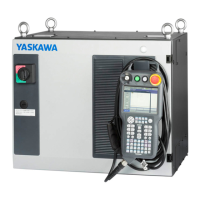1 Spot Welding Application Using a Motor Gun
1.4 System Setting (Motor Gun)
1-37
1.4.2.3 I/O Allocation
I/O Allocation Window
1. DRY TIP DRESS (WITHOUT PRESSING)
Use this signal to execute the tip dresser instruction (SVDRESMOV)
without pressure of the gun.
Refer to chapter 1.11.6 "Dry Tip Dressing Operation".
2. DRY TIP DRESS (WITHOUT DRESSING)
Use this signal to execute the tip dresser instruction (SVDRESMOV
instruction) without dressing.
Refer to chapter 1.11.6 "Dry Tip Dressing Operation".
3. GUN CHUCK (WELDER1)
Displayed when the gun change function is valid.
Also, shows the item(s) according to the number of the welders.
Use this signal to confirm the connection of the gun. In general, allocate
the chuck confirmation signal of ATC.
Refer to chapter 1.13.2 "Gun Change".
4. GUN UNCHUCK (WELDER1)
Displayed when the gun change function is valid.
Also, shows the item(s) according to the number of the welders.
Use this signal to confirm the disconnection of the gun. In general, allo-
cate the unchuck confirmation signal of ATC.
Refer to chapter 1.13.2 "Gun Change".
5. GUN ID NO. (WELDER1)
Displayed when the gun change function is valid.
Also, shows the item(s) according to the number of the welders.
This signals are binary signals to confirm the gun number.
Refer to chapter 1.13.2 "Gun Change".
6. GUN UNCHUCK REQUEST (WELDER1)
Displayed when the gun change function is valid.
Also, shows the item(s) according to the number of the welders.
Use this signal to disconnect the gun. In general, allocate the unchuck
signal of ATC. (Chuck=OFF, Unchuck=ON)
Refer to chapter 1.13.2 "Gun Change".
1
2
3
4
5
6

